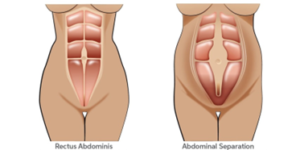What is Abdominal Separation?
Post-partum abdominal separation is also known as Diastasis of the Rectus Abdominis Muscle (DRAM). There is often misuse of language around this condition that can lead to fear, but it is important to note that there is no splitting or tearing of any muscles or ligaments.
DRAM refers to the separation of the rectus abdominis or ‘six-pack’ muscle through the stretching of the central ligament known as the linea-alba. The linea-alba runs down the mid-line from your ribs to pubic bone, and the separation can therefore occur at different locations down the abdominal wall, as shown below.

Abdominal separation normally begins in the second trimester of pregnancy as the abdominal wall undergoes dramatic changes as pregnancy progresses. As the fetus grows, there is increased intra-abdominal pressure as well as hormonal changes which contribute to the relaxing of connective tissue. This can lead to a widening and stretching of the linea-alba, which can present as doming or sagging of the abdominal wall.
Research shows that most women by the end of their pregnancy will have DRAM to some extent. It is a completely normal way for your body to make room for your growing baby. Most DRAMs will resolve on their own but some may need some help. Your physiotherapist will be able to assess and measure the degree of separation, as well as your function to help with a treatment plan.
Treatment
During pregnancy, there are things you can do to prevent the extent of separation and preserve the function of your abdominal wall. Generally, it is best to avoid putting excess strain on your abdominal muscles. This means:
- avoiding certain exercises,
- managing constipation to avoid pushing and straining,
- and learning how to move with a bump without straining your abdominals.
These are the things your midwife/physiotherapist can guide you with. Following birth, rehab and exercise is a key component to aid with recovery and healing. Your pelvic health physiotherapist can show you exercises that are suitable, as the tissue needs the right amount of load to stimulate collagen lay down and recovery of the linea-alba. Education will also be an important part of the treatment as there are a lot of myths out there about this condition which can cause confusion. More research is also being done to help us treat and manage DRAM better.
If you need professional advice regarding this condition please contact us on 09-5328942. Komal is a physiotherapist with a specific expertise in pelvic health.
– Komal Cleland – physiotherapist/pelvic health expert
